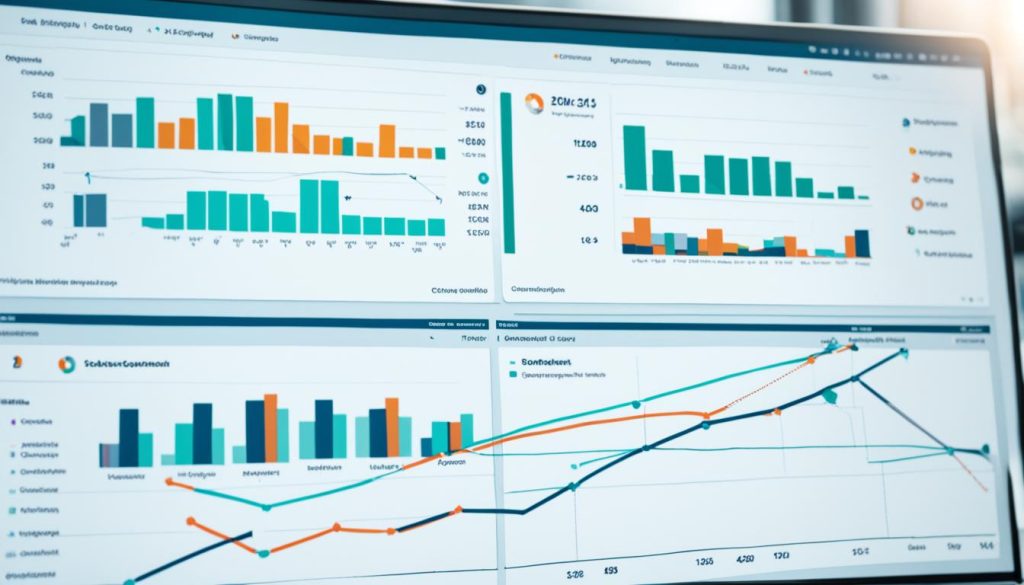Managing policies well is key to following the law, reducing risks, and keeping a strong governance structure. This guide will show you how to track your policies effectively. We’ll cover strategies and best practices, from keeping detailed audit trails to using data for smart decisions.
Key Takeaways
- Understand the importance of policies and the challenges of effective policy management
- Learn how to implement compliance monitoring and establish robust audit trails
- Discover the benefits of document control and version control for policy tracking
- Explore strategies for meeting regulatory requirements and mitigating risks
- Leverage process automation and data analytics to streamline policy management
Understanding Policy Management
Policies guide an organization’s actions and set its standards. They help follow the law and make decisions consistently. They also help manage risks. But, keeping track of these policies can be hard, especially for big organizations.
What Are Policies and Why Are They Important?
Policies are key to an organization’s rules. They tell employees how to act to meet the organization’s goals. Good policy management keeps an organization in line with laws and reduces risks. It also builds a culture of responsibility and openness.
The Challenges of Effective Policy Management
Many organizations struggle with managing policies well. They face issues like:
- Keeping policies current with new laws
- Applying policies the same way everywhere
- Tracking changes to policies
- Making policy documents easy to find and use
- Checking if employees know and follow policies
It’s important to overcome these challenges. Doing so helps an organization have a strong governance framework. It also helps with managing policies and staying compliant.

Good policy management is key to an organization’s success. By tackling challenges and using best practices, policies can stay up-to-date and effective. This helps the business succeed and stay strong.
The Importance of Compliance Monitoring
Keeping an eye on compliance is key for any business. It helps spot and fix policy issues, lowers legal and financial risks, and shows a company cares about doing things right.
It’s vital to watch over compliance in a company. This means making sure what a company does matches up with the laws and rules. Being proactive helps avoid big fines, keeps a good name, and stays ahead in the market.
Compliance monitoring is also a big help in risk mitigation. By checking how policies are working and finding any problems, companies can fix them fast. This keeps the company safe, protects its name, and keeps its operations honest.
Having a strong compliance monitoring system shows a company is serious about following the rules and being responsible. This is especially important for companies in strict industries or those with high ethical standards.
| Benefits of Compliance Monitoring | Key Considerations |
|---|---|
|
|
Putting compliance monitoring first helps companies avoid risks and build a culture of accountability and openness. This leads to long-term success and stability for the business.

“Effective compliance monitoring is essential for organizations to stay ahead of potential issues and maintain a positive reputation in the industry.”
Mastering the Art of Tracking Your Policies
Effective policy management is key for staying compliant, reducing risks, and keeping an organization well-run. At the core, it’s about tracking policies well. This lets organizations keep strong audit trails, manage document control well, and use data analytics to improve governance and follow rules better.
Establishing Robust Audit Trails
A strong audit trail is vital for tracking policies. It means keeping a detailed record of policy changes, approvals, and who did what. This makes it easier to check on compliance and answer questions from auditors quickly.
Implementing Effective Document Control
Good document control is also key for tracking policies. By keeping track of policy versions and their history, organizations make sure everyone has the latest approved policies. This helps avoid mistakes and keeps policies in line with the company’s goals.
Leveraging Data Analytics
In today’s world, data analytics is crucial for policy tracking. It helps spot trends, find oddities, and offer insights for better policy management. This way, organizations can fix policy issues early, improve compliance, and keep getting better at managing policies.
| Key Aspect | Benefit |
|---|---|
| Audit Trails | Enhances compliance monitoring and facilitates quick response to audits and regulatory inquiries. |
| Document Control | Ensures the accessibility of the most up-to-date and approved policies, preventing policy-related incidents. |
| Data Analytics | Provides valuable insights to proactively address policy gaps, enhance compliance, and continuously improve policy management practices. |
By focusing on these key areas of policy tracking, organizations can make the most of their policy management. This leads to a culture of following rules, managing risks, and always getting better.
Establishing Audit Trails
Effective policy management starts with keeping detailed records. Audit trails help track changes, document decisions, and watch user actions. Keeping up with policy updates, approvals, and user interactions makes an organization more transparent and accountable.
Documenting Policy Changes
It’s key to keep a record of policy changes. This means noting the reasons for updates, who approved them, and when they were put into action. A good system lets you easily see policy changes, making things clear and helping with smart decisions.
Monitoring User Access and Activity
Watching who looks at, changes, or approves policies is also vital. You should keep an eye on any tries to get into or mess with policy files without permission. This way, you can keep your policies safe and spot any security or rule problems.
| Feature | Benefit |
|---|---|
| Audit Trails | Enhance transparency and accountability in policy management |
| Documentation of Policy Changes | Maintain a clear record of policy evolution and decision-making |
| Monitoring User Access and Activity | Ensure the integrity of the policy framework and identify potential security or compliance issues |
By setting up strong audit trails, documenting changes, and watching user actions, organizations can handle policies well. This keeps them in line with rules and lowers risks. These steps are key for an organization’s policy framework to succeed and stay strong over time.
Implementing Document Control
Effective policy management needs strong document control steps. Using version control and keeping detailed revision histories helps. This makes sure the latest approved policies are easy to find. It also lowers the chance of confusion or conflict. And, it makes updating policies smoother.
Version Control and Revision History
Having a solid version control system is key for your organization’s policies. It lets you track changes and go back to older versions if needed. Plus, it keeps a clear record of how policies have changed over time.
A good revision history shows who made changes, when, and why. This makes managing policies and checking for compliance easier.
Here are some top tips for great document control and policy management:
- Put all policies in one place, with strict access and version control.
- Use a simple naming system and organize files well so policies are easy to find.
- Make sure policy changes get approved and signed off, and keep a detailed log of changes.
- Set up a system to automatically tell people about policy updates.
- Do regular checks to make sure your policy revision history is correct and complete.
| Feature | Benefit |
|---|---|
| Centralized policy repository | Ensures policies are easily accessible and version-controlled |
| Detailed revision history | Provides a clear audit trail of policy changes and approvals |
| Automated notification system | Keeps stakeholders informed of policy updates in a timely manner |
| Regular policy audits | Verifies the accuracy and completeness of policy management |
By following these tips, organizations can handle their policies well. They can make sure they follow the rules and keep a clear record of how they manage policies.
Meeting Regulatory Requirements
Meeting regulatory requirements is crucial for businesses in many fields. By keeping track of policies, companies show they follow the law and avoid big fines. This helps keep a good image with everyone who matters.
It’s vital for companies to keep up with regulatory rules. This means making sure they handle data privacy and follow specific industry rules. By doing this, they can lower risks and make sure they’re following the rules.
Keeping records of policy changes is important. This helps companies prove they’re trying to follow the law and answer questions quickly. By tracking policy updates and what users do, companies can protect themselves from legal problems.
| Regulatory Requirement | Key Policy Tracking Considerations |
|---|---|
| Data Privacy (GDPR, CCPA) | Monitoring access to and handling of personal data, documenting consent and processing activities |
| Financial Reporting (SOX, IFRS) | Tracking changes to accounting policies, maintaining audit trails for financial transactions |
| Industry-Specific Regulations (FDA, HIPAA) | Ensuring compliance with sector-specific guidelines, documenting policy updates and training |
By focusing on following the rules with good policy tracking, companies can avoid big fines and bad reputations. This keeps the business safe and shows they’re ethical. It also builds trust with everyone who matters.
Risk Mitigation Through Policy Tracking
Keeping an eye on policies is key to reducing risks for companies. By always checking policies and spotting any gaps or issues, businesses can fix problems early. This helps lower the chance of policy-related problems that could lead to big issues.
Identifying and Addressing Policy Gaps
Good policy tracking helps find where policies might be missing or not up to date. This lets companies fix these issues. It makes sure they have solid policies in place, reducing risks from policy gaps.
To find and fix policy gaps, companies should:
- Do regular checks on policies to see if they’re complete and still right for today.
- Use a system to keep all policies in one place and up to date.
- Make it clear who is in charge of making, checking, and keeping policies up to date.
- Have strong checks to see if people are following the policies.
- Have a plan for fixing policy gaps, like updating policies, training staff, and making sure everyone knows the rules.
By being proactive with policy tracking and finding gaps, companies can improve how they follow the rules. This lowers the chance of legal and operational risks. It also helps build a culture of being accountable and open.
| Key Benefits of Effective Policy Tracking | Potential Risks of Neglecting Policy Tracking |
|---|---|
|
|
By focusing on risk mitigation through good policy tracking, companies can handle policy gaps. This makes their compliance monitoring and organizational compliance stronger.
Building a Governance Framework
Creating a strong governance framework is key for managing an organization well. It sets up clear roles, responsibilities, and how decisions are made. This helps in better policy management and encourages compliance and ethical choices.
At the core, accountability is vital. It means defining who is in charge of making and enforcing policies. This makes things clear and ensures policies are followed everywhere in the organization.
Good governance also means having a clear way to make decisions. This includes rules for reviewing, approving, and updating policies. It also decides who can make policy decisions. Standardizing these steps helps in keeping an eye on compliance and reduces risks in managing policies.
A strong governance framework also has rules for checking and enforcing policy following. This could be through audits, reporting, or taking action against those who don’t follow the rules. Companies that focus on this part of policy management can spot and fix problems faster. This helps in better risk mitigation.
By investing in a solid governance framework, organizations can make their policy management smoother. They can keep an eye on compliance and reduce risks. This approach not only makes the organization more compliant but also builds a culture of accountability and ethical decisions.
Leveraging Process Automation
Organizations are now using process automation to make their policy management better. They use advanced technology to make reviewing and approving policies easier. This reduces mistakes and makes sure policies are applied the same way everywhere.
Streamlining Policy Review and Approval
The process of reviewing and approving policies can be slow and full of delays. Automation helps by making some steps automatic. This includes:
- Automated policy draft submission and distribution for review
- Seamless routing of policies to the right people for approval
- Real-time tracking of policy review and approval status
- Instant notification of policy changes and updates to the right people
Automation makes these processes faster and less work for people. It helps policies get reviewed and approved on time. This makes policy management and compliance monitoring better.
| Process Automation Benefits | Traditional Manual Approach |
|---|---|
| Efficient policy review and approval workflow | Lengthy, error-prone manual process |
| Reduced risk of human errors | Higher likelihood of mistakes and oversights |
| Consistent policy application across the organization | Inconsistent policy implementation |
| Real-time tracking and notification of policy changes | Lack of visibility and transparency |
Using process automation helps make policy review and approval smoother. It improves policy management and compliance monitoring. This leads to a more efficient and effective way of governing.
Utilizing Data Analytics
Data analytics is a key tool for companies looking to improve their policy management. It helps with monitoring compliance, reducing risks, and making better decisions. By using data analysis, companies can make their policy management better and stay ahead of new risks.
Data analytics helps find trends and patterns in policy data. It looks at policy changes, user actions, and compliance issues. This lets companies see where their policies might need work or more focus. They can then fix these areas, make processes smoother, and keep policies up-to-date with business and law changes.
Data analytics is also great for reducing risks. It spots high-risk policy areas or compliance issues early. This way, companies can fix problems before they get bigger. It makes the company stronger in governance and compliance, protecting its reputation and money.
For making decisions, data analytics gives leaders important insights. It shows how policy changes affect things, how well compliance is monitored, and how well risks are handled. This helps leaders make choices that help the company do well over time.
| Key Benefits of Data Analytics in Policy Management |
|---|
|
Using data analytics, companies can get a lot of insights. These insights help with better policy management, keeping an eye on compliance, and reducing risks. This approach makes governance stronger and helps the company succeed in a changing business world.
Conclusion
In this guide, we’ve looked at key strategies for mastering the art of tracking your policies. We talked about how to make strong audit trails and use data analytics. This helps make policy management smoother, keeps things in line with rules, and makes your governance framework stronger.
We also stressed the need for compliance monitoring and risk mitigation with policy tracking. Following these ideas helps you handle policy management better. It sets your organization up for success over time.
Starting your journey to track policies well means creating a detailed plan that fits your company’s goals and rules. With the right tools, steps, and attitude, you can make the most of your policy management efforts. This will bring lasting changes to your organization.






